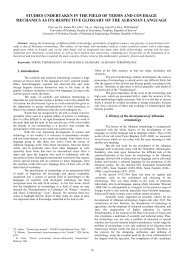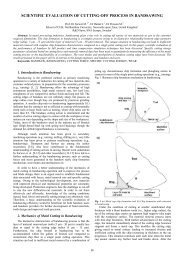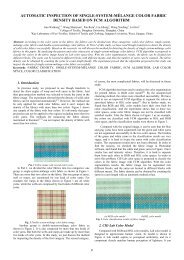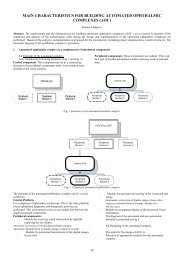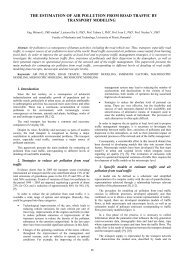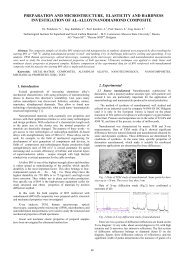issues, trends and research guidelines towards traffic safety
issues, trends and research guidelines towards traffic safety
issues, trends and research guidelines towards traffic safety
Create successful ePaper yourself
Turn your PDF publications into a flip-book with our unique Google optimized e-Paper software.
MACHINES, TECHNOLOGIES, MATERIALS. ISSN 1313-0226. ISSUE 5/2013<br />
MAIN ISSUES, TRENDS AND RESEARCH GUIDELINES TOWARDS TRAFFIC<br />
SAFETY<br />
Nikolay Georgiev, Violina Velyova<br />
University of Transport ‘Todor Kableshkov’, 1574 Sofia, 158 Geo Milev str., Bulgaria<br />
Abstract: The rapid development of road transport <strong>and</strong> serious reliance of modern human society on its services is an undeniable fact. At<br />
the same time, the past <strong>and</strong> present of this transport mode are inextricably linked to a number of problems related to <strong>traffic</strong> management.<br />
Therefore, the need of development <strong>and</strong> implementation of effective measures to increase the level of <strong>traffic</strong> <strong>safety</strong> becomes more important.<br />
These measures should be fulfilled at different organizational levels (e.g. urban planning, improvement of organization <strong>and</strong> <strong>traffic</strong><br />
management systems, vehicle design, transport infrastructure, etc.). Undoubtedly, the most important of them are connected with <strong>traffic</strong> flow<br />
characteristics, which require a profound analysis, especially about their connection with <strong>safety</strong> requirements.<br />
In this sense, the present article discusses the relation of operational <strong>safety</strong> with the potential of conflicts between road users (conflict<br />
situations) due to the impact of some influencing factors. These factors include: state <strong>and</strong>/or local policy on road <strong>safety</strong>, characteristics of<br />
<strong>traffic</strong> flows, technical features of vehicles, human behaviour, weather conditions, <strong>traffic</strong> management, etc. In the context of said above, here<br />
several approaches for analysis <strong>and</strong> evaluation of road transport <strong>safety</strong> have been considered. Their strengths, weaknesses, applicability <strong>and</strong><br />
need to develop are also discussed.<br />
Keywords: TRAFFIC ACCIDENT PREDICTION MODELS, ROAD TRANSPORT SAFETY, APPROACHES, VEHICLE, TRAFFIC<br />
1. Introduction<br />
The rapid development of road transport <strong>and</strong> the strong reliance<br />
of modern human society on its services is an undeniable fact. At<br />
the same time, the past <strong>and</strong> present of this type of transport are<br />
inextricably linked to a number of problems of organization <strong>and</strong><br />
<strong>traffic</strong> <strong>safety</strong> on the roads <strong>and</strong> streets. For example, in 2009 more<br />
than 35,000 people were killed in <strong>traffic</strong> accidents on the roads of<br />
the European Union (Fig. 1) <strong>and</strong> about 1.5 million were seriously<br />
injured. Property damages are enormous <strong>and</strong> estimated at not less<br />
than 130 billion EUR [9].<br />
Fig.1<br />
All this raises the need to develop <strong>and</strong> implement effective<br />
measures to increase the level of <strong>traffic</strong> <strong>safety</strong>. These measures<br />
should be implemented at different levels (e.g. urban planning,<br />
improving systems of organization <strong>and</strong> <strong>traffic</strong> management, design,<br />
construction <strong>and</strong> improvement of the transport infrastructure, etc.)<br />
<strong>and</strong> no doubt require in-depth <strong>research</strong> to identify of the laws <strong>and</strong><br />
the characteristics of the movement of vehicles. What is essential in<br />
this aspect is the study of the impact of various operating<br />
parameters (e.g. the characteristics of <strong>traffic</strong> flows, the specifics <strong>and</strong><br />
technical condition of transport infrastructure, organization <strong>and</strong><br />
management of <strong>traffic</strong> flows, etc.) on <strong>safety</strong>.<br />
The analysis of current approaches, concepts, <strong>research</strong> results<br />
<strong>and</strong> directions for future <strong>research</strong> in the area of transport <strong>safety</strong> is<br />
the main goal of this article.<br />
2. Nature <strong>and</strong> characteristics of road transport<br />
<strong>safety</strong><br />
Road transport <strong>safety</strong> is a complex concept, which involves all<br />
available approaches, methods <strong>and</strong> activities for management of<br />
risks aimed at road participants (drivers of vehicles, passengers,<br />
20<br />
pedestrians, etc.), material assets (vehicles, transport infrastructure,<br />
etc.) or the environment.<br />
Typical feature of transport is the movement of physical objects<br />
(vehicles). Conflicts between them are highly undesirable events<br />
<strong>and</strong> their prevention (or reducing consequences after their<br />
occurrence) is a main priority in systems for <strong>traffic</strong> organization <strong>and</strong><br />
<strong>safety</strong> management.<br />
Operational environment with potential for conflicts between<br />
road participants (conflict situation) may occur due to the influence<br />
of a number of factors. These factors include: state <strong>and</strong> / or local<br />
policy on road <strong>safety</strong>, the characteristics of <strong>traffic</strong> flows, the<br />
technical condition <strong>and</strong> the characteristics of vehicle <strong>and</strong> road<br />
network, human behavior, weather, organization <strong>and</strong> management<br />
of <strong>traffic</strong> <strong>and</strong> more. Figure 2 shows the correlation (<strong>and</strong> interaction)<br />
between the influencing factors on road <strong>safety</strong> known as: Driver -<br />
Vehicle - Road - Environment (operating conditions) System.<br />
Driver Vehicle Road<br />
Operating Conditions<br />
Fig.2.Driver - Vehicle - Road System<br />
It should be recognized that there are a number of scientific<br />
studies on the negative impact on road <strong>safety</strong> of the mentioned<br />
above factors. Figure 3 shows the proportion of different factors to<br />
the occurrence of road accidents according to the data proposed in<br />
[8].<br />
Road factors 34%<br />
3%<br />
1%<br />
26%<br />
2%<br />
57%<br />
4%<br />
6%<br />
Vehicle factors 13%<br />
Human<br />
behaviour<br />
factors 93%<br />
Fig.3.Proportion of different factors influencing <strong>traffic</strong> <strong>safety</strong><br />
A specific feature of road transport is the large number of<br />
interacting vehicles moving in different directions. If in the course<br />
of its movement, two (or more) vehicles simultaneously "bring
MACHINES, TECHNOLOGIES, MATERIALS. ISSN 1313-0226. ISSUE 5/2013<br />
intention" to "occupy" the same restricted area, an unusual<br />
(complex) operating situation occurs with a potential for conflict<br />
between these vehicles. Further development of the complicated<br />
situation may be terminated as a result of timely <strong>and</strong> adequate<br />
actions of drivers of vehicles. If the behavior of drivers is<br />
inadequate, the complicated situation could easily develop into an<br />
emergency situation (potentially dangerous situation) that requires<br />
immediate action <strong>and</strong> high professionalism of the drivers to avoid<br />
conflict (<strong>traffic</strong> accident), for example: a sudden change of speed or<br />
movement direction, extreme (emergency) braking, etc.<br />
It should be noted that the occurrence (<strong>and</strong> also the<br />
development) of a potentially dangerous situation largely depends<br />
on the <strong>traffic</strong> organization, the characteristics of <strong>traffic</strong> flows, the<br />
weather <strong>and</strong> the condition of the transport infrastructure. Even the<br />
smallest changes in the characteristics of these factors lead to<br />
significant changes in the parameters of the <strong>traffic</strong>, <strong>and</strong> hence the<br />
probability of occurrence of abnormal <strong>and</strong> emergency situations.<br />
This should be taken into account when conducting <strong>research</strong> on<br />
road <strong>safety</strong>: approaches, methods <strong>and</strong> models for analysis <strong>and</strong><br />
forecasting, analysis <strong>and</strong> evaluation of influencing factors, choice of<br />
the most appropriate measures for increasing <strong>safety</strong>, etc.<br />
3. Overview of Approaches for the Analysis <strong>and</strong><br />
Evaluation of Road Transport Safety<br />
There are a large number of scientific papers <strong>and</strong> publications<br />
on methods <strong>and</strong> approaches for assessing road <strong>safety</strong> <strong>and</strong><br />
influencing factors. What unites them all is the search for an<br />
appropriate solution for improving road <strong>safety</strong> depending on<br />
individual characteristics: areas designated as hazardous after<br />
conducted surveys (black spots or black sites); roads <strong>and</strong> areas<br />
typical with particular accident types at a number of individual sites<br />
throughout the area.<br />
In this part, the article will concentrate on some basic methods<br />
<strong>and</strong> <strong>traffic</strong> <strong>safety</strong> models with the aim of clarifying their advantages<br />
<strong>and</strong> disadvantages. Thus, the main factors that influence <strong>traffic</strong><br />
<strong>safety</strong> <strong>and</strong> the fundamental models used around the world <strong>and</strong> in the<br />
European Union will be determined.<br />
Each local authority in the European Union under the Road<br />
Traffic Act is required to improve road <strong>safety</strong>. In fulfilling these<br />
responsibilities, public funds are invested in projects aimed at<br />
analysis, evaluation <strong>and</strong> improvement of road <strong>safety</strong> <strong>and</strong> necessity<br />
to take measures for reducing road accidents. Improved flow should<br />
lead to: decrease of travel time, vehicle emissions, fuel usage,<br />
psychological stress on drivers, <strong>and</strong> improved <strong>safety</strong>.<br />
In order to create a suitable transport approach (model) for<br />
prediction of <strong>traffic</strong> accidents it is necessary to answer to a few<br />
basic questions:<br />
• Influential Factors: Which engineering factors influence<br />
accidents rate. Are these factors the same or different from those<br />
found in past studies?<br />
• Extent of Influence: Does each influential factor affect<br />
accidents <strong>and</strong> to what extent? Which factors are not significant,<br />
marginally significant, or very significant?<br />
• Possible Countermeasures: What are the engineering<br />
treatments for addressing specific <strong>safety</strong> problems?<br />
• Efficacy of Countermeasures: What are the <strong>traffic</strong><br />
accident reduction factors. For example, how many lives can be<br />
expected to be saved for every 1 m increase in shoulder width? [3]<br />
According to reference [3], factors that influence <strong>traffic</strong> <strong>safety</strong><br />
include: engineering (roadway) features, vehicle <strong>and</strong> operator<br />
characteristics, environmental features, <strong>and</strong> levels of education <strong>and</strong><br />
enforcement of legislation geared <strong>towards</strong> safe road use. The study<br />
focuses only on the engineering features of the road (Fig. 4).<br />
21<br />
Engineering<br />
Factors<br />
Sectional Factors<br />
Alignement<br />
Roadway<br />
Shoulder<br />
Roadside Features<br />
Traffic Control Devices<br />
Section Length, Section Traffic Volume<br />
Vertical Alignment, Horizontal Alignment<br />
Lane width, pavement surface type, pavement friction<br />
Shoulder type, shoulder width, shoulder rumble strips<br />
Side slopes, ditches, obstructions (fences, road<br />
signs, etc.(utility poles)<br />
Pavement markings, road signs, etc.<br />
Fig.4.Explanatory Engineering Factors Affectig Crashes<br />
Traffic accident prediction models are developed for each<br />
highway functional class for four <strong>traffic</strong> accident severity<br />
categories: injury <strong>traffic</strong> accident; property damage only <strong>traffic</strong><br />
accidents; fatal <strong>and</strong> injury <strong>traffic</strong> accidents <strong>and</strong> total <strong>traffic</strong><br />
accidents. Based on this set of information, the factors affecting<br />
<strong>traffic</strong> accident occurrences are defined: the section length, <strong>traffic</strong><br />
volume, lane <strong>and</strong> shoulder width, pavement friction, average<br />
horizontal curve radius, average vertical grade, driveway density.<br />
Prerequisites to <strong>traffic</strong> accident modeling basically include<br />
developing a <strong>traffic</strong> accident database (with roadway characteristics<br />
such as <strong>traffic</strong> volumes, geometric design features, <strong>traffic</strong> control<br />
features, <strong>and</strong> <strong>traffic</strong> accident history) <strong>and</strong> selecting an appropriate<br />
functional form.<br />
According to reference [4], despite numerous findings made in<br />
improving the estimation tools of statistical models, the most<br />
common probabilistic structure used for modeling motor vehicle<br />
<strong>traffic</strong> accidents remains the traditional Poisson <strong>and</strong> Poisson-gamma<br />
(or Negative Binomial) distribution.<br />
For example, study [3] shows the use of Poisson <strong>and</strong> Negative<br />
Binomial models. It is made for rural two-lane roads in Indiana.<br />
Each of 540 rural two-lane state highway segments <strong>and</strong> a sample of<br />
107 county road segment lengths are explored for the period from<br />
1997 to 2000. Four functional classes are studied: rural collectors,<br />
rural minor arterials, rural principal arterials on the state highway<br />
system, <strong>and</strong> county roads.<br />
The general form of <strong>traffic</strong> accident models derived using a<br />
Poisson model is:<br />
(1) = ⎜<br />
⎛<br />
⎟<br />
⎞<br />
⎝∑<br />
⎠<br />
i i<br />
β<br />
A kLQ exp γ χ ,<br />
where:<br />
A - number of <strong>traffic</strong> accidents in a selected time period;<br />
L - length of the section;<br />
Q - average daily <strong>traffic</strong> on the section;<br />
χi - explanatory variable;<br />
k , β , γ i - constants estimated from the modeling process.<br />
Negative Binomial model allows additional variance<br />
representing the effect of omitted variables. Using negative<br />
binomial regression analysis, some <strong>traffic</strong> accident prediction<br />
models for three different <strong>traffic</strong> accident severity categories are<br />
obtained – all <strong>traffic</strong> accidents, property damage only <strong>traffic</strong><br />
accidents, <strong>traffic</strong> accident, fatal <strong>and</strong> injury <strong>traffic</strong> accidents.<br />
Negative Binomial Regression <strong>and</strong> Poisson regression are also<br />
used as base approaches in [6]. In this study, D100/22 State<br />
highway section on the way to Şebinkarahisar (Turkey) is<br />
examined. The number of <strong>traffic</strong> accidents in accordance to<br />
kilometer <strong>and</strong> geometrical properties of the highway,<br />
environmental, highway <strong>and</strong> <strong>traffic</strong> signs condition, field conditions<br />
at night <strong>and</strong> during daytime, are taken into consideration.<br />
When it comes to modeling small samples, the Poisson-gamma<br />
model is usually the choice of transportation <strong>safety</strong> modelers.<br />
Poisson-gamma models problems, defined as the “low mean<br />
problem” (LMP) are the topic in [4].
The primary objective of this <strong>research</strong> project was to verify<br />
whether the LMP affects the estimation of the dispersion parameter<br />
<strong>and</strong>, if it was, to determine the magnitude of the problem. To<br />
accomplish the objective of the study, a series of Poisson-gamma<br />
distributions were simulated using different values describing the<br />
mean, the dispersion parameter, <strong>and</strong> the sample size.<br />
The functional form of the model is:<br />
(2)<br />
where:<br />
MACHINES, TECHNOLOGIES, MATERIALS. ISSN 1313-0226. ISSUE 5/2013<br />
β β<br />
B = ,<br />
β 1 2<br />
0 i, 1 i,<br />
2<br />
F F<br />
B - predicted number of <strong>traffic</strong> accidents for the site i;<br />
F i,<br />
1 , Fi, 2 - entering Annual Average Daily Traffic flows for the<br />
major <strong>and</strong> minor approaches for site i;<br />
β 0 , β 1 , β2 - coefficients to be estimated.<br />
Although the functional form is not the most adequate for<br />
describing the relationship between <strong>traffic</strong> accidents <strong>and</strong> exposure,<br />
it is still the most favored by transportation <strong>safety</strong> modelers for<br />
modeling <strong>traffic</strong> accident data at intersections. There are three<br />
estimators that are commonly used: the Method of Moments, the<br />
Weighted Regression, <strong>and</strong> the Maximum Likelihood Method. What<br />
is essential to know is that, if the dispersion parameter is<br />
misestimated, common analyses performed in <strong>traffic</strong> <strong>safety</strong> could be<br />
seriously undermined.<br />
Another study uses Generalized Linear Model Technics [5].<br />
This study is based upon data of personal injury road accidents<br />
reported to the Police which occurred on the Lothian major road<br />
network during a four year period 1979-1982. A computer program<br />
called GLIM (Generalized Linear Interactive Modeling) was<br />
adopted for the study <strong>and</strong> the purpose of the model was to explore<br />
the relationships that may exist between road accidents <strong>and</strong> <strong>traffic</strong><br />
flows on different parts of the road network. To obtain appropriate<br />
data it was necessary to have both road accident <strong>and</strong> <strong>traffic</strong> flow<br />
information. The LORASS (Lothian Road Accident Statistics<br />
System) was the chosen software because it provided a<br />
comprehensive source for such data. Another computer program,<br />
called TRAMS (Transport Referencing <strong>and</strong> Mapping System) was<br />
installed by the Region to support this model of the road network.<br />
Each junction is identified by its LORASS node number <strong>and</strong> the<br />
software GLIM does not simply represent a complex junction as a<br />
single node but a series of nodes each showing particular <strong>traffic</strong><br />
conflict points. One disadvantage of the technique is that LORASS<br />
codes are not universally accepted, i.e. determined to some extent<br />
by the subjective judgment of the <strong>research</strong>er. Another difficulty is<br />
related to the investigation of accidents- the study data have a<br />
marginally higher proportion of accidents at junctions than those for<br />
Great Britain. This observation may be explained by the relatively<br />
high proportion of urban road miles in Lothian Region, suggesting a<br />
higher than average number of junctions per road kilometer.<br />
Generalized Linear Modeling Approach in which Negative<br />
Binomial (NB) regression models is used in [2]. This model is<br />
developed for the City of Toronto <strong>and</strong> the variables that had<br />
significant effects on accident occurrence are: the number of<br />
households, major road kilometers, vehicle kilometers travelled,<br />
intersection density, posted speed <strong>and</strong> volume-capacity ratio.<br />
A Geographic Weighted Regression (GWR) approach is<br />
employed to test spatial variations in the estimated parameters from<br />
zone to zone but it is a relatively new technique that permits the<br />
parameter estimates to vary locally rather than globally. The basic<br />
idea of GWR is that a regression model is fitted at each point, i.e.,<br />
weighting all observations by a function of distance from that point.<br />
The major disadvantage of the GWR method, <strong>and</strong> its software, is<br />
the assumption of normally distributed errors which are not valid<br />
for accident prediction modeling.<br />
22<br />
It is important to mention that, data availability <strong>and</strong> logical<br />
considerations influenced the process used to select the independent<br />
variables in the models. However, it is recognized that a model with<br />
too many variables may perform poorly with a new sample of data<br />
from the same population. Description of statistic data in [2] is<br />
divided by: socioeconomic <strong>and</strong> demographic characteristics,<br />
number of intersections, road kilometers, <strong>traffic</strong> dem<strong>and</strong> <strong>and</strong><br />
variables.<br />
Another case study that uses data for more than 1000 Traffic<br />
accidents in Southern California identifies twenty-one <strong>traffic</strong> flow<br />
regimes for three different ambient conditions: dry roads during<br />
daylight, dry roads at night, <strong>and</strong> wet conditions [1]. This <strong>research</strong><br />
uses a disaggregate approach, in which the units of analysis are the<br />
<strong>traffic</strong> accidents themselves, rather than aggregations of <strong>traffic</strong><br />
accidents over time <strong>and</strong> space. There are three sets of variables in<br />
the disaggregate approach: the characteristics of the <strong>traffic</strong> accident<br />
<strong>and</strong> of the <strong>traffic</strong> flow, the time of the <strong>traffic</strong> accident, measured at a<br />
location as close to the site of the <strong>traffic</strong> accident as possible, <strong>and</strong><br />
environmental conditions, such as highway geometry, roadway <strong>and</strong><br />
weather conditions, <strong>and</strong> visibility.<br />
Two of the methods used are linear: principal components<br />
analysis, the most common form of factor analysis, <strong>and</strong> cluster<br />
analysis.<br />
Principal components analysis is used to interpret the<br />
correlation structure among <strong>traffic</strong> flow variables in terms of a<br />
smaller number of independent linear combinations, called factors.<br />
Cluster analysis is a similarly widely used method of grouping<br />
observations based on similar data structure. This analysis is used in<br />
order to find homogenous groups of <strong>traffic</strong> flow conditions, which<br />
they call “regimes.”<br />
The third type of multivariate analysis is Nonlinear<br />
(Nonparametric) Canonical Correlation Analysis (NLCCA), which<br />
is not commonly used in transportation <strong>research</strong>. NLCCA is<br />
designed for problems with variable sets that contain categorical or<br />
ordinal (Nonlinear) variables. The analysis techniques are<br />
somewhat unconventional to this domain of study. This analysis<br />
applies only to urban freeways with at least three lanes in each<br />
direction, <strong>and</strong> the specific results apply to conditions during 1998 in<br />
Orange County, California, but validation has not yet been<br />
conducted, so the degree of spatial transferability cannot be<br />
confirmed.<br />
There are various other different approaches for analysis <strong>and</strong><br />
evaluation of road <strong>safety</strong>.<br />
In reference [7] are considered 23 different approaches. “Risk<br />
Evaluation by Modeling of Passing Behaviour”, is about overtaking<br />
maneuvers on rural roads, based on road geometry <strong>and</strong> driver<br />
characteristics (ages <strong>and</strong> gender). The negative aspect in relation to<br />
EURSI (European Road Safety Inspection) is that it addresses only<br />
one type of a collision scenario. It’s the same with the following<br />
projects: “Assessing Traffic accident Risk on Road Curves”,<br />
“Effects of Geometric Design Consistency on Road Safety”,<br />
“Roadside Point Hazards”; “5-level Roadside Hazardousness<br />
Index”.<br />
Approaches used for the analysis <strong>and</strong> evaluation of road<br />
transport <strong>safety</strong> are: different <strong>safety</strong> indexes (“Safety Assessment on<br />
Accidents, Traffic Flow <strong>and</strong> Facilities”), General Linear<br />
Regressions (“Effects of Geometric Design Consistency on Road<br />
Safety”). Hierarchical Full Bayesian models were developed to<br />
relate <strong>traffic</strong> accident frequencies with various risk factors<br />
associated with adverse weather, road alignments <strong>and</strong> <strong>traffic</strong><br />
characteristics in “Bayesian hierarchical approach for developing<br />
<strong>safety</strong> performance functions”, Empirical Bayesian algorithm is<br />
used in “TARVA”, Data Collections based on GPS based surveys is<br />
used in “Web GIS for Road Risk Analysis” <strong>and</strong> so on.
MACHINES, TECHNOLOGIES, MATERIALS. ISSN 1313-0226. ISSUE 5/2013<br />
3.1 Strengths, weaknesses <strong>and</strong> applicability of the<br />
Approaches<br />
We can conclude that in terms of approaches for assessing road<br />
<strong>safety</strong>, there are various different approaches to predict accidents,<br />
but they can be generalized to the following main types of modeling<br />
techniques: Generalized Linear Modeling, Poisson <strong>and</strong> Negative<br />
Binomial model. There are also a few innovative ways of modeling<br />
<strong>traffic</strong> <strong>safety</strong>, such as the nonlinear (nonparametric) canonical<br />
correlation analysis, Generalized Linear Interactive modeling <strong>and</strong><br />
the use of GIS in transport <strong>safety</strong> which are usually a collaboration<br />
of the well-known above models. Each of the approaches has its<br />
own strong points <strong>and</strong> weaknesses. In most approaches, difficulties<br />
arise from the collection of extensive statistical database if it does<br />
not exist so far.<br />
The Generalized Linear Interactive modeling that is proposed in<br />
[5] is a flexible model from the viewpoint of the possibilities that it<br />
suggests. It has the same weakness as others like this: contains a<br />
common component on both sides of the equation. This problem<br />
exists in the analysis of relationships, for example: between<br />
accident rate <strong>and</strong> <strong>traffic</strong> on links where the dependent variable<br />
would be accidents per million vehicle kilometers <strong>and</strong> the<br />
independent variable would be million vehicles. According to the<br />
<strong>research</strong> significant improvements to the models are achieved by<br />
the application of empirical Bayesian methods. Interestingly, in the<br />
<strong>research</strong>, the accident rate was found to decrease with increasing<br />
<strong>traffic</strong> intensity.<br />
As regards Poisson <strong>and</strong> Negative Binomial model, which are<br />
used in a variety of studies (for example reference [3]), the<br />
proposed models suggest additional possibilities with suitable set of<br />
variables. The difficulty appears with the data collecting, the<br />
selection of significant <strong>and</strong> the definition of insignificant variables<br />
<strong>and</strong> also the estimation of parameters of the model for conditions<br />
outside Indiana. We can rightly conclude that the negative aspects<br />
of Poisson- Gamma models, discussed in [4], are the same together<br />
with the fact if the dispersion parameter is misestimated, common<br />
analyses performed in <strong>traffic</strong> <strong>safety</strong> could be seriously undermined.<br />
In scientific papers [6] <strong>and</strong> [1] the advantages of the models are<br />
related to the possibility for establishment of elaborate transport<br />
model, influenced by a sufficient number of variables. The<br />
<strong>research</strong>er concludes that it is crucial to take into account <strong>traffic</strong><br />
accidents report, environmental conditions <strong>and</strong> highway geometric<br />
characteristic to determine the risky <strong>and</strong> dangerous sections on<br />
interurban highway. In this way all of the effects caused <strong>traffic</strong><br />
accidents would have been taken into consideration.<br />
When talking about Nonlinear (Nonparametric) Canonical<br />
Correlation Analysis (NLCCA) [1], which is a disaggregated<br />
approach united to cluster analysis, disadvantages are related to the<br />
collection of statistical information <strong>and</strong> the complexity of the<br />
model, because the cluster needs grouping of the variables, which<br />
could be partially subjective.<br />
Some authors prefer to use more types of parallel but separate<br />
techniques. This is the case in [2]: the model mainly depends on<br />
variables, which are not generally known <strong>and</strong> are obtained<br />
according to the specific conditions. The major disadvantage is the<br />
assumption of normally distributed errors.<br />
4. Conclusion<br />
The forms <strong>and</strong> types of accident models vary considerably. It<br />
has been shown that individual types of models (e.g. different types<br />
of models for each intersection) are of great interest but do not lead<br />
to the production of significantly improved model for each accident<br />
than the so called “all accidents model”. Furthermore, the “all<br />
accident model” has proven its stability over the years <strong>and</strong> enjoys<br />
the confidence to predict future levels of <strong>safety</strong>.<br />
Experience in the studies of accidents at roads shows that they<br />
are due to a combination of the following factors: highway<br />
geometry, driver <strong>and</strong> vehicle characteristics <strong>and</strong> the environment.<br />
23<br />
Accidents are typically caused by an interaction of more than two of<br />
these factors.<br />
The process of collecting crash database is expensive <strong>and</strong> needs<br />
to contain descriptions on the following: date, time, location of the<br />
<strong>traffic</strong> accident; number of injured <strong>and</strong> vehicle involved; accident<br />
severity; drivers physical condition; light <strong>and</strong> weather conditions;<br />
collision type; distance from the intersection; roadway segment<br />
length; <strong>traffic</strong> flow; surface type <strong>and</strong> so on. The difficulty of<br />
creating models derives from the large number of experimental<br />
data, which needs to be collected <strong>and</strong> correctly assessed.<br />
The present state of the art in the field of <strong>traffic</strong> <strong>safety</strong> shows<br />
that the negatives of most developed models are associated with<br />
their severe individuality, i.e. the need to do the <strong>research</strong> for small<br />
areas because of labour intensity in the collection of information.<br />
The models’ results depend mainly on variables which are generally<br />
known <strong>and</strong> are prepared according to the particular conditions. The<br />
key difficulty comes from the need of collecting complex <strong>and</strong><br />
considerable amount of data most of which include significant <strong>and</strong><br />
insignificant variables. Despite numerous studies, the identification<br />
of significant <strong>and</strong> insignificant variables is difficult <strong>and</strong> to some<br />
extent subjective, <strong>and</strong> therefore care must be taken at the same time<br />
not to aggravate the model, but to be made enough accurate for the<br />
conditions.<br />
As for Bulgarian conditions, modeling the influencing factors<br />
on road <strong>safety</strong> is not at the core of planning <strong>and</strong> management of<br />
urban <strong>traffic</strong>. In other words, the correlation of known <strong>and</strong><br />
discussed in this article approaches <strong>and</strong> methods for Bulgarian<br />
conditions is not checked. The main problem here is the collection<br />
<strong>and</strong> processing of a sufficient number of real data on the<br />
characteristics of accidents (number, type, location, etc.), transport<br />
infrastructure, <strong>traffic</strong> flows, etc. It is necessary to analyze <strong>and</strong> verify<br />
the applicability <strong>and</strong> the need for improvement (for the conditions<br />
of country) of the available methods <strong>and</strong> models in this area.<br />
Achieving this goal will contribute to improve the level of transport<br />
reliability <strong>and</strong> <strong>safety</strong>.<br />
References<br />
[1] Golob, T., Recker, W. A Method for Relating of Crush to<br />
Traffic Flow Characteristics on Urban Freeways. University of<br />
California, Burkeley. California Partners for Advanced Transit <strong>and</strong><br />
Highways. 2003.<br />
[2] Hadayeghi, A., Shalaby, A., Persaud, B. Macro-level<br />
Accident Prediction Models for Evaluating the Safety of Urban<br />
Transportation Systems. Toronto, Canada. 2003.<br />
[3] Labi, Samuel. Effects of Geometric Characteristics of Rural<br />
Two-Lane Roads on Safety. Joint Transportation Research Program<br />
Technical Report Series. Purdue University. 2006.<br />
[4] Lord, Dominique. Modeling Motor Vehicle Traffic accidents<br />
using Poisson-gamma Models: Examining the Effects of Low<br />
Sample Mean Values <strong>and</strong> Small Sample Size on the Estimation of<br />
the Fixed Dispersion Parameter. Texas A&M University, College<br />
Station, TX. 2006.<br />
[5] McGuigan, David. An Examination of Relationships<br />
between Road Accidents <strong>and</strong> Traffic Flows. University of<br />
Newcastle upon Tyne. 1987.<br />
[6] Özgan, Ercan. Evaluation Accident Risk on Interurban<br />
Rural Highways, Sivas Sampling. Düzce University, Turkey.<br />
[7] Project Nr. 823129, D 3.2 Risk Assessment Review, Project<br />
initiated by ERA-NET ROAD, 2011.<br />
[8] Road Accident Investigation Guidelines for Road Engineers.<br />
PIARC, 2007.<br />
[9] Towards a European road <strong>safety</strong> area- policy orientations<br />
on road <strong>safety</strong> 2011-2020, European Commission, 2010.



